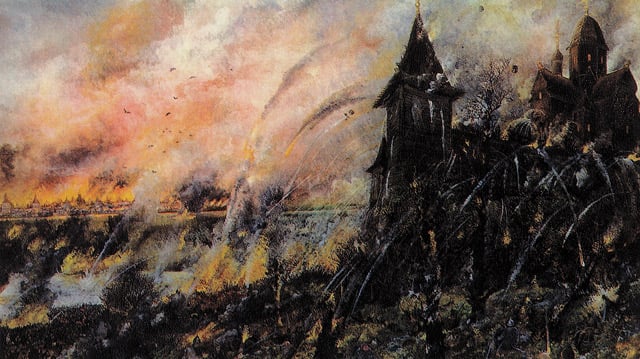*Image Credit: Wikimedia Commons Almost two centuries after Genghis Khan captured much of Asia, the remnants of the vast Mongol Empire were beginning to disintegrate. For the better part of 50 years, the khanate had been killing its own during fierce internal fighting, but on December 5, 1408, Edigu led the Golden Horde — the last successor in Eastern Europe to Genghis’ marauders of the early 13th century — into Moscow for one final show of force. Born in the Crimea, territory that now lies in the northern Black Sea to the south of Ukraine, Edigu was raised in the Muslim tradition. Building approval thanks to successful campaigns on behalf of Khan Tokhtamysh of the Golden Horde during the 1380s and 1390s, Edigu managed to reign over territory between the Volga and Ural Rivers himself. Just 400 miles to the southeast of Moscow, Edigu controlled valuable land for commerce on the Black Sea. Looking to secure more power, he formed a rebel army with Temur Qutlugh to claim the region separate from Tokhtamysh’s armies. After a four-year war, Qutlugh was crowned leader of the Golden Horde, with Edigu named his top general. When Qutlugh died at the Battle of the Vorskla River in the summer of 1399, his Commander-in-Chief took over as the head of the tribe by default. After leading the White Horde to victory, Edigu was in a unique position to unify the khanate and launch an attack on the Grand Prince of Russia. With Tokhtamysh on the run and presumed dead, Edigu led the Golden Horde into Moscow on December 5, 1408 to force the duke to admit Mongol supremacy and submit to taxes as a conquered people. It would be the last triumph for the remnants of one of the largest continuous empires the world has ever seen. Over the next decade, Edigu maintained only brief control over the area. Within two years, he had been pushed into the highlands of Central Asia. In 1419, after approaching his homeland to the north of the Black Sea, Edigu was killed by the sons of his old enemy Tokhtamysh. Fractured and shrinking, what was left of the khanate devolved into a shadow of its former self over the next century. With tribal forces in the Balkans gaining strength, the descendant of the Mongol Empire shrank to a comparatively small swath of land between the Black and Caspian Seas. By the time Sultan Mehmed II conquered Constantinople in 1453, the Lithuanians, Bulgarians, Moldavians and Russians had come back to thrash the remaining Mongols. When Ivan the Great succeeded his father as Grand Prince of Moscow in 1462, Edigu’s victory was now a distant memory. A century after the leader of the Golden Horde took the Russian capital, much of the land Edigu ruled was part of a new Russian Empire. Also On This Day: 771 – Charlemagne becomes King of the Franks, uniting the tribes after the death of his brother 1848 – United States President James K. Polk informs the US Congress there are large amounts of gold in California, launching the Gold Rush 1932 – Physicist Albert Einstein is granted a visa for his move to the United States 1943 – Allied Air Forces launch Operation Crossbow against secret German facilities for the V-2 rocket 1969 – ARPANET, the precursor to the Internet, completes its planned four-computer network linking the University of California-Los Angeles, Stanford University, the University of California-Santa Barbara and the University of Utah 5th December, 1958 – Subscriber Trunk Dialling (STD) is inaugurated in the UK by Queen Elizabeth II when she speaks to the Lord Provost in a call from Bristol to Edinburgh. 5th December, 1360 – The French Franc is created. 5th December, 1492 – Columbus discovers Hispaniola (El Espanola/Haiti). 5th December, 1840 – Napoleon Bonaparte receives a French state funeral in Paris 19 years after his death. 5th December, 1879 – 1st automatic telephone switching system patented.
December 5 1408 – The Golden Horde Marches into Moscow
*Image Credit: Wikimedia Commons Almost two centuries after Genghis Khan captured much of Asia, the remnants of the vast Mongol Empire were beginning to disintegrate. For the better part of…
